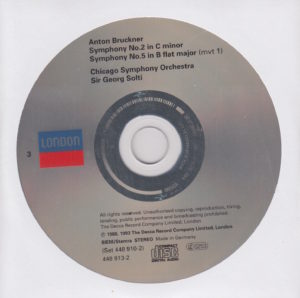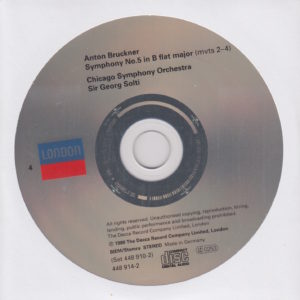 This morning’s conductor of Anton Bruckner’s Symphony No. 5 in B-Flat Major (WAB 105) – nicknamed “Tragic,” “Church of Faith,” or “Pizzicato” symphony (for reasons I’m still discovering) – is Hungarian-born Sir Georg Solti (1912-1997), an artist with a long and noteworthy career.
This morning’s conductor of Anton Bruckner’s Symphony No. 5 in B-Flat Major (WAB 105) – nicknamed “Tragic,” “Church of Faith,” or “Pizzicato” symphony (for reasons I’m still discovering) – is Hungarian-born Sir Georg Solti (1912-1997), an artist with a long and noteworthy career.
I first heard Sir Georg Solti on Day 14 of my 144-day journey.
Then again on Day 30.
And Day 46.
 And, most recently, on Day 62.
And, most recently, on Day 62.
Given that this symphony is split over two CDs, I can conclude one thing for sure about it: It’s over 79 minutes long, which earns this the coveted “Yikes!” award for length.
It’s been awhile since I first blogged at length about Maestro Solti. So I’ll reproduce some of what I posted back on Day 14 to remind myself who this man was. From his entry on Wikipedia:
Sir Georg Solti, KBE (21 October 1912 – 5 September 1997) was an orchestral and operatic conductor, best known for his appearances with opera companies in Munich, Frankfurt and London, and as a long-serving music director of the Chicago Symphony Orchestra. Born in Budapest, he studied there with Béla Bartók, Leó Weiner and Ernő Dohnányi. In the 1930s, he was a répétiteur at the Hungarian State Opera and worked at the Salzburg Festival for Arturo Toscanini. His career was interrupted by the rise of the Nazis, and being of Jewish background he fled the increasingly restrictive anti-semitic laws in 1938. After conducting a season of Russian ballet in London at the Royal Opera House he found refuge in Switzerland, where he remained during the Second World War. Prohibited from conducting there, he earned a living as a pianist.
Known in his early years for the intensity of his music making, Solti was widely considered to have mellowed as a conductor in later years. He recorded many works two or three times at various stages of his career, and was a prolific recording artist, making more than 250 recordings, including 45 complete opera sets. The most famous of his recordings is probably Decca’s complete set of Wagner’s Der Ring des Nibelungen, made between 1958 and 1965. Solti’s Ring has twice been voted the greatest recording ever made, in polls for Gramophone magazine in 1999 and the BBC’s Music Magazine in 2012. Solti was repeatedly honoured by the recording industry with awards throughout his career, including a record 32 Grammy Awards as a recording artist.
Another fine biography of Sir Georg can be found here, on the Decca label web site. (Solti’s official web site is gone. The URL points to the Decca label site; however, not to a Solti page. You have to search for Sir Georg’s bio in the drop-down menu.)
Sir Georg’s passing was covered by The New York Times here.
From the NYT obituary:
More than many of his colleagues, Sir Georg insisted that the precision and bright coloration that could be achieved in the recording studio could be duplicated in the concert hall. Particularly during his Chicago years, he prized a sizzling brass sound and a rich string tone that could be thrilling in Bruckner and Mahler, and that also served him well in Beethoven and Mozart.
This is one of there reasons why I do projects like these – so I can learn about the performers as well as the composers.
Unfortunately, listening this morning, I noticed there is a problem with the digital file in Movement I, from about 19:30 onward, especially around 19:50-20:00. Skipping and repeating of music. It’s a glitch, for sure.
I’m hoping that’s just a one-time occurrence in the file on my laptop that arose when I ripped it – and not on the CD itself. If it is on the CD, I’ll have to return the set, which shouldn’t be too much fun since I bought it many months ago and am now just hearing Symphony No. 5.
Note to self: Check this when I get home later today.
Okay, now on to the objective aspects of this recording:
 Bruckner’s Symphony No. 5 in B-Flat Major (WAB 105) composed in 1875-1876
Bruckner’s Symphony No. 5 in B-Flat Major (WAB 105) composed in 1875-1876
Sir Georg Solti conducts
Solti used the ??? version, edited by ???
Chicago Symphony Orchestra plays
The symphony clocks in at 80:00 (Yikes!)
This was recorded in January of 1980 at Medinah Temple, Chicago
Solti was 68 when he conducted it
Bruckner was 51 when he finished composing it
This recording was released on the London/Decca label
According to its entry on Wikipedia,
1878 version
This is the version normally performed. It exists in editions by Robert Haas (published 1935) and Leopold Nowak (published 1951) which are almost identical.
That’s my best guess as to the version Solti chose – the 1878. However, neither the liner notes nor the CD sleeve provide any information about the version or the editor – Nowak? or Haas?
Bruckner wrote his symphonies in four parts. The time breakdown of this one (Symphony No. 5 in B Flat Major, version and edition unknown), from this particular conductor (Solti) and this particular orchestra (Chicago Symphony Orchestra) is as follows:
I. Introduction (Adagio) — Allegro. B-flat major……………………………20:27
II. Adagio. Sehr langsam. (Very slowly) D minor……………………………21:37
III. Scherzo. Molto vivace D minor…………………………………………………13:25
IV. Finale (Adagio) — Allegro moderato. B-flat major…………………..23:48
Total running time: 80:00
As I’ve written from the get-go regarding my project, I’m no musicologist.
So my observations are objective only in the sense that I rely on those who are musicologists to tell me what’s going on.
 One of the most egg-head of my Bruckner musicologist books is The Cambridge Companion to Bruckner, edited by John Williamson.
One of the most egg-head of my Bruckner musicologist books is The Cambridge Companion to Bruckner, edited by John Williamson.
In the chapter titled “The Brucknerian symphony: an overview,” written by Williamson, I read on page 83,
There is, however, a qualitative difference between the cases of Mozart and Bruckner that is partly a matter of technique, partly of tone. The Finale of the Fifth Symphony illustrates the similarities and the contrasts. The presentation of the fugue subject in the clarinet is humorous, particularly in its contrast with the opening string polyphony. Once heard in these tones the fugue subject never quite throws off the impression of irreverence, particularly in the manic repetitions that offset the choral theme in the development. Yet its combination of wide leaps with the narrow semitonal motion anticiaptes the fugue subject of Psalm 150, which urges ‘Alles was Odem hat, lobe den Herrn!’ This fusion of contrasting tones helps to explain why Bruckner became a symphonist rather than remained a composer of church music.
See? That’s musicologist stuff.
If you want a scholarly analysis of Bruckner’s music, I’m not sure you could go wrong with the Cambridge companion.
Okay. Now, here are the subjective aspects:
My Rating:
Recording quality: 4
Overall musicianship: 5
CD liner notes: 4 (extensive essays about Bruckner and his symphonic style in German, French, English, and what appears to be Portuguese – however, no mention of the record label anywhere in its 56 pages, nor is there adequate information about the version used. Which version isn’t usually mentioned.)
How does this make me feel: 4
When I listen to each conductor’s interpretation of each symphony, I don’t go back to read what I wrote before – not in the subjective area, anyway. I try to let each recording speak to me.
Today’s Symphony No. 5 in B Flat Major, as interpreted by Sir Georg Solti and performed by the Chicago Symphony Orchestra is a fine piece of music, from the low thrum, thrum, thrum at the opening of Movement I to the massive close of the Finale in Movement IV.
One of the reasons why I enjoy listening to Bruckner’s symphonies is because he uses one of my favorite instruments a lot (the French horn) and employs one of my favorite techniques a lot (Pizzicato). I know going in that I’m apt to hear both in a Bruckner symphony.
And I’m correct, especially about the pizzicato.
My favorite movements in this performance are Movement III (Scherzo) and Movement IV (Finale). Both hold my attention quite easily because of the interplay between the instruments and the highs and lows, the quiets and louds, that form these compositions.
I don’t remember what I thought of Sir Georg’s previous interpretations. But I enjoyed this one quite a bit.
